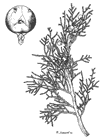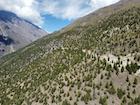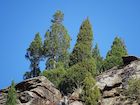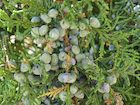Juniperus excelsa
Marschall von Bieberstein 1800
Common names
Greek juniper (Vidakovic 1991); dhup (var. polycarpos, in India).
Taxonomic notes
Synonymy:
- Juniperus sabina var. taurica Pall., Fl. Ross. 1789;
- Juniperus sabina var. excelsa (M.-Bieb.) Georgi 1800;
- Juniperus foetida var. excelsa (M.-Bieb.) Spach 1841;
- Juniperus isophyllos K. Koch 1849;
- Sabina excelsa (M.-Bieb) Ant. 1857;
- Sabina religiosa Ant. 1857;
- Sabina isophyllos (K. Koch) Ant. 1857;
- Sabina olivieri Ant. 1857;
- Juniperus taurica (Pall.) Lipsky (non Lindl.) 1912;
- Juniperus excelsa var. depressa O. Schwarz 1934;
- J. olivieri Carr.
There are two subspecies, excelsa and polycarpos (K. Koch) Takhtajan 1972. "The morphological differences observed [between the subspecies] are in part clinal. Geographically and ecologically there is some overlap with the typical subspecies, but both taxa occupy for the greater part distinct ranges and habitats. Treatment as a subspecies, proposed by Takhtajan (Takhtajan and Fedorov, 1972), seems therefore the best taxonomic judgement" (Farjon 1992).
Additional synonymy for subsp. polycarpos includes:
- Juniperus polycarpos K. Koch 1849;
- Sabina polycarpos Ant. 1857;
- Juniperus excelsa Wall. 1880;
- Juniperus macropoda Boiss. 1884;
- Juniperus turcomanica B.A. Fedtsch. 1932;
- Juniperus seravschanica Komarov 1932;
- Sabina seravschanica (Komarov) Nevski 1937;
- Juniperus polycarpos var. seravschanica (Komarov) Kitamura 1964;
- Juniperus polycarpos var. pendula Mulk. 1967;
- Juniperus excelsa var. farreana P.N. Mehra 1976;
- Juniperus excelsa var. polycarpos (K. Koch) Silba 1984;
- Juniperus excelsa subsp. polycarpos var. pendula (Mulk.) Imkhanitskaya 1990;
- Juniperus excelsa subsp. seravschanica (Komarov) Imkhanitskaya 1990;
- Juniperus excelsa subsp. turcomanica (B.A. Fedtsch.) Imkhanitskaya 1990.
Description
Trees (sometimes shrubs or prostrate shrubs) to 25 m tall and 250 cm dbh, usually with a single trunk; crown broadly pyramidal in young trees, with age becoming broad, irregular, or shrub-like to prostrate in alpine locations. Bark first smooth, soon with papery flakes, reddish-brown, later fibrous, becoming longitudinally furrowed and peeling in long strips; purplish- to reddish-brown. Twigs numerous, arrayed in dorsiventral sprays in young trees, or more irregular and very dense, esp. in dry environments; ultimate twigs covered with leaves, quadrangular to round, diameter only 0.7-1 mm. Juvenile leaves on seedlings or on lower, shaded branches of trees are ternate, acicular, c. 8-10 x 1 mm, widest at base, keeled, pungent; mature leaves scale-like, decussate, imbricate, appressed or free at the mostly incurved apex, decurrent at base, ovate-rhombic on ultimate branchlets, (ob)lanceolate-acute on older shoots (-3.5 mm long), 0.6-1.1 × 0.4-0.8 mm, with entire margins; glands large and conspicuous, elliptic to nearly circular, often resinous; stomata on juvenile leaves epistomatic, on mature leaves amphistomatic, mostly in 2 inconspicuous lines tapering from base to apex, light green or yellowish-green; both juvenile and mature leaves have a single median resin cavitv. Pollen cones numerous, solitary and terminal or subterminal on ultimate branchlets, 3-4 × 2-3 mm, greenish maturing yellowish; microsporophylls 8-10, peltate with rounded, thin margins, each bearing 3-4 pollen sacs. Seed cones numerous, mostly solitary and axillary, subterminal on ultimate branchlets, sessile; young cones surrounded by green leaves or bracts, 2-3 mm diameter, purplish-green to blue; mature cones globose, 10 mm diameter, purplish-brown to blackish-purple, often pruinose; seed scales 4(-6), decussate, entirely fused with bracts and each other, the two largest meeting at the distal pole of the cone, 4-9 mm long, surface smooth, waxy, with a ridge terminating in a small umbo (0.5-0.6 mm), interior resinous, becoming woody, yellowish. Seeds (2-)3-6(-8) per cone (some ovules usually abort), angular, broadest at base, ovoid but flattened or curved, 4-6 × 3-4 mm, yellowish to reddish-brown (Farjon 1992).
Subspecies polycarpos differs from the typical subspecies in the following characters: Ultimate branchlets more quadrangular, thicker (1-1.3 mm), often irregularly disposed and intricate, leaves on ultimate branchlets sometimes free at apex, larger (1.2-1.6 × 0.8-0.9 mm); female cones similar to the typical subspecies but with on average fewer seeds (2-)3-4(-6) and sometimes larger cones (up to 14 mm), and more variable in size (Farjon 1992).
Distribution and Ecology
Albania, Yugoslavia (Macedonia), Greece (Macedonia, Thraki and Euboea), S Bulgaria, Turkey (Anatolia and eastward to Armenia), Cyprus, Syria, Lebanon, Georgia, Armenia, Azerbaijan, Iran (Elburz Mts.) to near Ashkhabad (Kopet Mts.) in Turkmenia, Afghanistan, Pakistan (Baluchistan), Tadzhikistan, Uzbekistan, and India (Himachal Pradesh) (Farjon 1992). Hardy to Zone 6 (cold hardiness limit between -23.2°C and -17.8°C) (Bannister and Neuner 2001).
"Juniperus excelsa M.-Bieb. subsp. excelsa occurs in the hills and mountains of the Eastern Mediterranean Basin, the Black Sea and a range of mountains arching around the southern end of the Caspian Sea. It becomes increasingly rare eastward along the latter chain of mountains. It does not occur in regions with an annual precipitation much below 500 mm. It is especially common in Anatolia (less so in its central part) and on the Crimea, with annual precipitation between 500-1000 mm. Its altidudinal range is from c. 100 m (e.g. Crimea) to 2300 m in the Caucasus and Turkey. It forms the tree-limit in several mountain ranges. It is resistant to summer drought and warmth, but less so than the subsp. polycarpos (discussed below). It grows mainly on stony, rocky calcareous or non-calcareous slopes. It may form pure, open forests, grow mixed with J. foetidissima or with other conifers such as Cedrus libani, Cupressus sempervirens and Pinus spp., or it may be part of oak-scrub communities in secondary vegetation, but not in Mediterranean maquis.
"Juniperus excelsa subsp. polycarpos is found from the mountains around the Çoruh Valley in E Turkey eastward across the Caucasian Region to the Caspian Sea. Thence it occurs eastward around the Caspian Sea and along the Kopet Mountains into Afghanistan. Northeastward it reaches the Tian Shan and the mountains of Kirgizstan, in the south(east) of the range it is found as far as Quetta in Pakistan and Himachal Pradesh (India). In Iran it is mostly scattered along the mountain chains west of the great desert plateaus; finally there is a disjunct population on Jabal-al-Akhdar in Oman.
"Juniperus excelsa subsp. polycarpos is much more a continental taxon than the typical subspecies. It occurs in the Western Asiatic Subregion of the Irano-Turanian Region, and especially in the Armeno-Iranian Province (see Takhtajan, 1986: 144), characterized by mountains separated by vast steppes and deserts. The Jabal-al-Akhdar in Oman forms a disjunct enclave of this Province (Takhtajan, 1986: 149), which has its western limit in the eastern parts of Turkey roughly from Gümüshane to Maras. West of this line Juniperus excelsa subsp. polycarpos does not occur. It is possibly sympatric with the typical subspecies only in Armenia (including Turkish Armenia), and along the mountain chains from Azerbaijan eastward around the southern end of the Caspian Sea, where the typical subspecies becomes increasingly rare. Precipitation is still relatively high in these mountains (usually well above 500 mm annually). Often identified as J. seravschanica, Juniperus excelsa subsp. polycarpos occurs abundantly farther east in Afghanistan and in Tadzhikistan and Uzbekistan, with outposts in the western Tian Shan on the northern limits and in India (Himachal Pradesh) at the southeastern end of its range. Precipitation is less abundant, much of it comes as snow in winter. It is generally a higher altitude taxon and the further it reaches eastwards, the higher altitude it attains (see also Browicz and Zielinski, 1982); it occurs from 500-3800 m (Kitamura, 1960), but generally between 1200-3000 m. It grows exceedingly slow and in many areas groves of very old trees occur, with little or no rejuvenation. It is much more resistant to drought and radiation (heat) than the typical subspecies and strongly heliophilous, but it can tolerate winter cold equally well. Dehydration is prevented by an exceptionally thick cuticula. It occurs on stony, rocky slopes, often spaced wide apart, sometimes mixed with J. semiglobosa" (Farjon 1992).
In Iran, subsp. polycarpos is dominant, with Pistacia khinjuk and P. atlantica, in the Junipereto-Pistacietea steppe forest (Liphschitz et al. 1979).
"In Eurasia, an increased adaptation to continentality can be observed through the taxa J. excela subsp. excelsa, J. foetidissima, J. excelsa subsp. polycarpos, and J. semiglobosa. The more equatorial distribution of J. procera ensures a less extreme range of seasonal temperatures, as well as a climate where more moisture is generally available. The distribution of at least two species is also generally connected with major orogenetic events. The East African distribution of J. procera concurs largely with the volcanic uplands adjacent to and associated with the Great Rift systems, along which this species has reached 18°08' S. J. semiglobosa, the most distinct species taxonomically, is a true high altitude species of the mountains in Central Asia. While it crosses a relatively important floristic barrier to the SE, its limit in that direction is nevertheless climatically determined. Increased precipitation levels prevent its eastward expansion, which may be of relatively recent date connected with the rapid uplift of the Karakoram Range (1500 m since the last ice age and still in progress); it is not known from Nepal. For the most part, the geographical ranges found for [these] taxa ... coincide well with the floristic (sub-)regions and provinces as defined by Takhtajan (1986)" (Farjon 1992).
Remarkable Specimens
The age record is 318 years, derived from a cut tree used in a dendroclimatic study (Liphschitz et al. 1979).
Ethnobotany
The wood is very durable and of good quality (Vidakovic 1991).
Liphschitz et al. (1979) used subsp. polycarpos in an exploratory dendroclimatic study in the Elburz Mountains. In an unusually destructive study (trees were sampled by cross-sectioning) they found trees up to 318 years old, succeeded in crossdating samples and developing a master chronology, and found that growth was strongly positively correlated with fall precipitation and fall temperature.
Observations
"Macedonia is the northwest border of its distribution. There it occurs also in almost pure stands around the Vardar River, Pcinja, Anska Reka, Demir-Kapija, Crna Reka and Lake Prespansko, between 100 and 800 m elevation, on lime and silicate mother rocks" (Vidakovic 1991).
Vladimir Dinets (E-mail, 2004.11.14) found it in Pakistan: Hazarganji-Chintal National Park near Qwetta.
Remarks
The epithet excelsa means "high", perhaps referring to how tall this species gets, compared to other European junipers.
Citations
Liphschitz, N., Y. Waisel and S. Lev-Yadun. 1979. Dendrochronological investigations in Iran. Tree-Ring Bulletin 39:39-45.
See also
Ali, S.I. and M. Qaiser (eds.). 1987. Flora of Pakistan. http://www.efloras.org/flora_page.aspx?flora_id=5, accessed 2010.11.18, now defunct.
Elwes and Henry 1906-1913 at the Biodiversity Heritage Library. This series of volumes, privately printed, provides some of the most engaging descriptions of conifers ever published. Although they only treat species cultivated in the U.K. and Ireland, and the taxonomy is a bit dated, still these accounts are thorough, treating such topics as species description, range, varieties, exceptionally old or tall specimens, remarkable trees, and cultivation. Despite being over a century old, they are generally accurate, and are illustrated with some remarkable photographs and lithographs.
Farjon (2005) provides a detailed account, with illustrations.
Takhtajan, A. L. 1986. Floristic regions of the world (trans. T. Crovello). Berkeley: University of California Press.




